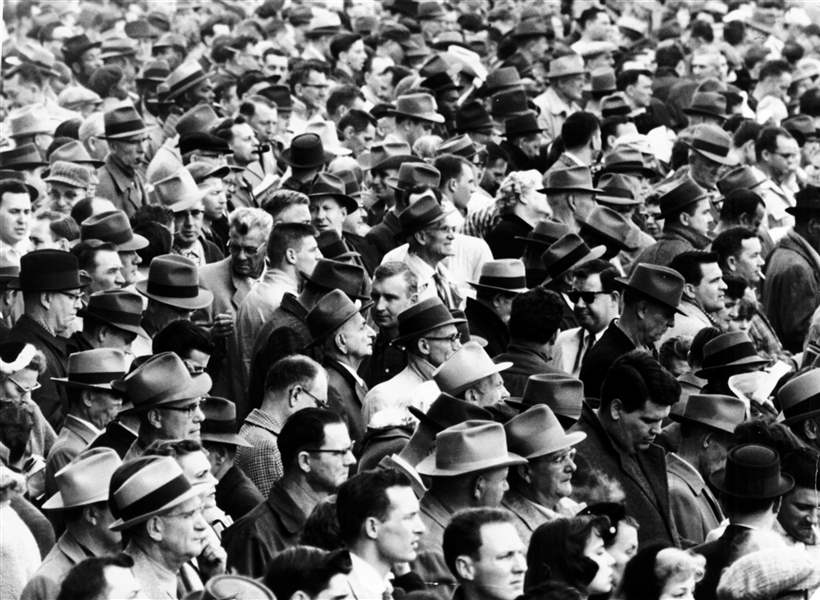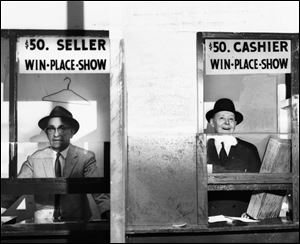
Plan to move Raceway Park threatens a local tradition dating to 19th century
2/13/2011
A crowd gathers in April, 1959, to watch the races at the former Maumee Downs. In its history, the track offered both thoroughbred and harness racing.
THE BLADE/ARCHIVE FILE PHOTO
Buy This Image
The sign along the Detroit Avenue side of the Raceway Park property proclaims the track offers the "Best Bet in Toledo."
But with a potential move to the Youngstown area, Toledo's more than century-old tradition of live horse racing may have completed the home stretch.
Fort Miami Fairgrounds, Maumee Downs, and most recently Raceway Park have attracted huge crowds and substantial wagers at times and a dedicated core of horse-racing fans throughout most of their existence.
Still, local live horse racing may be squeezed by the battle over a shrinking slice of the gambling/entertainment pie as Raceway's owner, Penn National Gaming Inc., proposes to uproot the track from Toledo — where the company also is building a casino.
Penn National's plan is contingent on the state approving video game slots.
"Horse racing has been a big part of Toledo for a very long time, but it looks like that could be changing," said Seymour Rothman, a retired Blade sports writer who was a fixture at Raceway Park in the 1960s when crowds in excess of 5,000 were commonplace.
"People used to love it. They would go out to the track for dinner, then walk through the paddock to watch how the horses were behaving, just to see if you could get a hunch of any kind. You stayed for all of the races, placed your bets, and made a real evening of it."
Mr. Rothman recalled Raceway's inaugural season of horse racing in the fall of 1959 when even a torrential downpour on the opening day did not scare off the huge crowd, which wagered $168,564 on the eight-race card of thoroughbred events. Raceway later moved to staging strictly harness racing.
"When horse racing came to Raceway Park, it was something new, so it got a lot of attention," Mr. Rothman said. "In its heyday, Raceway attracted a wide range of people. It wasn't a particularly affluent crowd, like you were at a polo game, but it was just a case where if you liked the horses, that's where you went."
A local tradition
Horse racing's deepest roots in the area go back into the 19th century.
"Horse racing in northwest Ohio is extraordinarily historic," said John Pawlak, a weekend sports anchor at WTOL-TV, Channel 11 from 1971-78 who went to work at Raceway Park from 1978-85 before moving on to the United States Trotting Association, where he is director of public relations.
"Starting with the county fairs, it is probably 150 to 160 years old, and then with Fort Miami, then Maumee Downs, and Raceway Park — there's been a lot of horse racing history written there in Toledo."

A crowd gathers in April, 1959, to watch the races at the former Maumee Downs. In its history, the track offered both thoroughbred and harness racing.
The Fort Miami Fairgrounds race track and then Maumee Downs were both at the current site of the Lucas County Recreation Center, and the tracks staged thoroughbred and harness racing events.
Making history
Fort Miami made horse racing history in 1929 when it became the first track in the country to install a lighting system and hold night sessions of harness racing. The notion was that night racing would allow the track to be patronized by working folks, and the feature attracted record crowds to Fort Miami.
The lighting system was designed and implemented by Toledo Edison Co., and some of the hundreds of horses stabled at the track at the time were used in test sessions over a period of weeks to acclimate them to the lights and allow the lighting system to be tweaked.
‘Colorful characters'
Fort Miami's 1957 season was hanging in the balance in December, 1956, when Ohio Racing Commission Chairman Zoltan Gombos charged that track operator Ralph A. Parachek and his Toledo Turf Club Inc. were engaged in a "milking operation" that was skimming the profits off the business but not enhancing the facility, as had been promised when Mr. Parachek took over.
Commission member Otto Elliott went even further. "Ralph Parachek is just stubborn or selfish. We're trying to make him see the light. We don't want the Toledo track to be a dump," Mr. Elliott said at the time.
There were also rumblings about a new horse racing operation planned for Washington Township and other rumors that a Detroit syndicate was considering putting horse racing in at Raceway Park, which at the time hosted auto racing.
"That was the thing with horse racing here in Toledo, and everywhere across the country. There were a lot of colorful characters involved, and some were less than reputable," Mr. Rothman said. "They kept things interesting because there were a lot of shenanigans going on."
The Maumee Downs track was on what became the playing field for the Mud Hens at Ned Skeldon Stadium, Mr. Pawlak said. The bleachers along the third base line at Ned Skeldon Stadium served as the grandstands when horse racing was staged there.
"The clubhouse under the bleachers had a terrazzo floor with jockeys' boots and hats as part of the pattern. It's another little piece of that rich history of horse racing around Toledo," he said.
The Raceway era
Raceway Park was founded and owned by Sylvester "Shake" Jechura and his brothers, who opened the facility in 1949 for stock car racing. It was licensed as a horse track in 1958.
Once horse racing moved out to Raceway Park, between Telegraph Road and Detroit Avenue just south of Alexis Road, the facility first staged thoroughbred races. Because that style of racing was more expensive to maintain and much more vulnerable to quirks in the weather, harness racing eventually prevailed.

In 1959, Bill Pote, left, and Neil Sullivan invite fans to place their bets at the former Maumee Downs. It drew a loyal following of racing fans.
"We had horrible weather in the spring of 1972, and one point a couple horses went down on a particularly soft patch on the track, so the jockeys got together and refused to ride," said Tom Sorosiak, a cousin of Mr. Jechura who worked at Raceway Park for more than 50 years.
"That was a disastrous season financially for Raceway, so the decision was made to go to harness racing since it took less track maintenance, and you could run in some bad weather. It's always the bottom line that drives change in horse racing, so we did that to be competitive."
Nearby competition
Raceway Park also was tussling with a pair of tracks in the Detroit area for fans and bettors, and the facility sought dates from the state racing commission that would allow it to hold races when the Detroit tracks were idle.
"Competition from the Michigan tracks was a big concern," Mr. Rothman said, "because the feeling was that a lot of Toledoans would go to the races, but it was the Detroiters who bet the big money. That wasn't entirely true, but there were quite a few days when the parking lot would be full of Michigan license plates. We depended a lot on Detroit money."
Hazel Park Raceway is still operational, but Detroit Race Course in Livonia has since closed.
Under the lights
Night harness racing came to Raceway Park in 1962, and three years later the track was banked to make speeds more competitive with other harness facilities.
"We had to go to a track that was fast because everybody in harness racing was talking about running a sub-two-minute mile, and you couldn't get that on a flat surface," Mr. Sorosiak said. He added that the faster times brought more top harness racers, and that brought more customers to the betting windows. Weekends with 6,000 fans and wagers exceeding $250,000 were common, Mr. Sorosiak said.
A run of bad luck
A 1976 fire at Raceway Park destroyed four horse barns and killed 40 horses. The next year the grandstand and clubhouse burned, but Mr. Jechura rebuilt and brought in state-of-the-art computer equipment to assist in handling the pari-mutuel wagering.
"There was a time when we hand-figured all of the payouts by pencil," Mr. Sorosiak said. "As soon as the race was over, they were in line at the windows wanting their money, so we had to work fast. Before everything was automated, there was a lot of work to be done in those first few minutes after a race."
A crowd of almost 7,000 was on hand when Raceway reopened after the second fire, and more than $300,000 was wagered at the windows. Fans could then sit in the new enclosed grandstand.
Mr. Jechura sold his interest in the track in 1988 and retired to Florida. He died in 2009.
Mr. Sorosiak said that during the time the Jechura family owned Raceway Park, it was not uncommon to see prominent members of Toledo's business community there, as well as celebrities. Baseball great Pete Rose and members of the Detroit Tigers took in the races.
A shifting landscape
Mr. Rothman said changes in ownership seemed to affect the track's level of success.
"Raceway, most of the time, it was a well-run track," Mr. Rothman said. "When it was a family-run operation, they kept the barns open year-round and really took care of the people involved. Then another outfit took over, and the attention to detail was not even close to the same. Everyone could see it slipping."
Raceway Park is slated to open this year's racing schedule on April 30, with 52 dates planned, but Penn National's expressed desire to move the horse-racing operation has left a lot of uncertainty. Mr. Pawlak and others in the horse-racing business voiced concern over the possible end of live racing in Toledo.
"This move seems to really short-change the racing community there," Mr. Pawlak said.
"Horse racing has been part of the area for so long, and it would be a shame to see that rich legacy just end. Many people still want to go to the track — they still want to go for a dinner and the show — they want to see it all," he said.
Mark Headworth of Oregon, the top-earning driver for 2010, said he moved to the area for the sole purpose of racing at Raceway Park.
But Mr. Headworth acknowledged that the size of the winning purses at Raceway has declined in the last decade, as have the number of racing days. "We used to always open up the first of March and run up until Christmastime, then we only had to travel in January," he said.
Mr. Rothman said interest in attending live races has been waning for some time, and he believes it could mark the end of an era.
"We've got off-track betting and lotteries and now these new casinos — all competing for the same dollars," he said.
"That other stuff is too easy, so horse racing might lose out. At the racetrack, you would study the horses, examine the field, and spend a lot of time making your choices. With slot machines, you just pull the lever. There's not much thought to it."
Contact Matt Markey at: mmarkey@theblade.com or 419-724-6510.